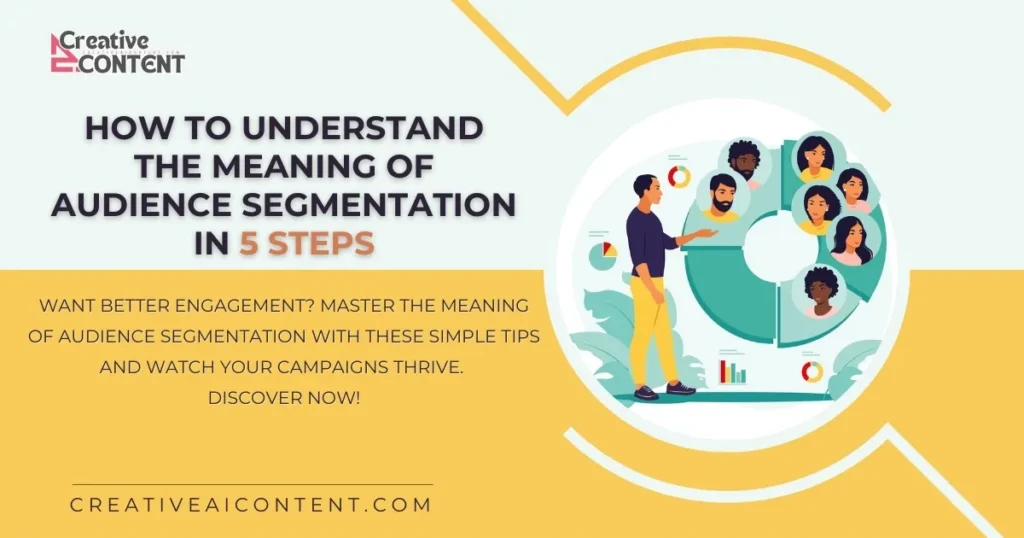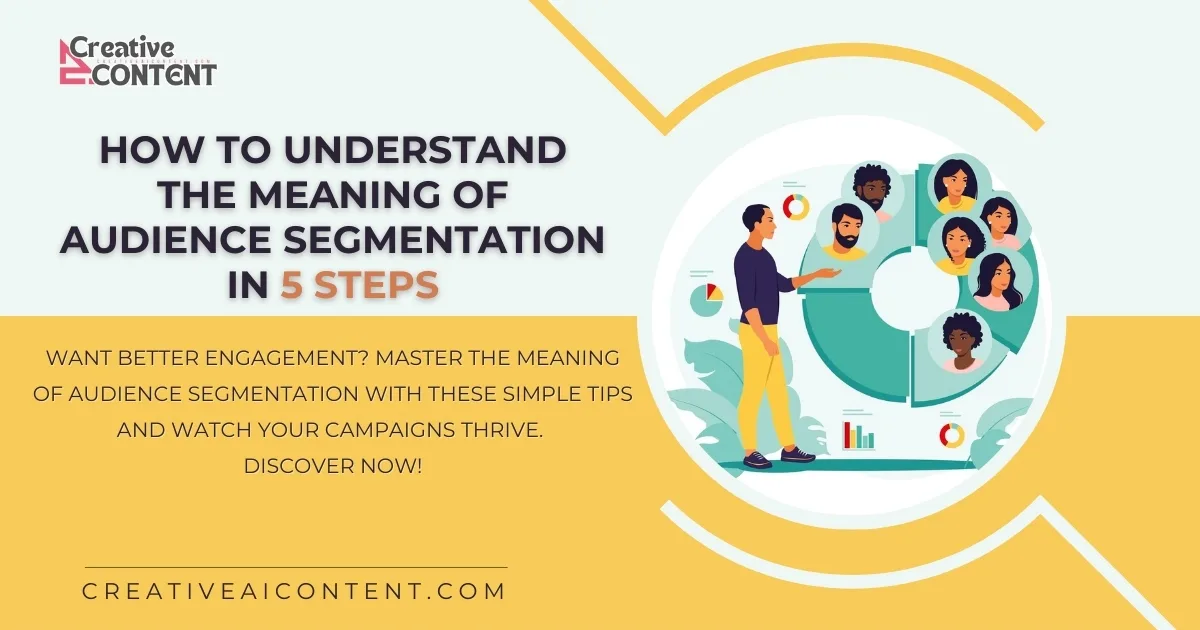Have you ever wondered why some marketing campaigns seem to hit the mark while others fall flat? The secret often lies in understanding your audience—and that’s where the meaning of audience segmentation comes into play. Simply put, audience segmentation is about dividing your broad audience into smaller groups based on shared traits like age, location, or interests. For small business owners and entrepreneurs, mastering this concept can be a game-changer. It helps you create tailored strategies that improve engagement, boost conversions, and maximize your return on investment (ROI). In this guide, we’ll walk you through five simple steps to understand the meaning of audience segmentation and apply it effectively to your marketing efforts.

- What Is Audience Segmentation?
- Why Does the Meaning of Audience Segmentation Matter?
- Step 1: Identify Your Audience
- Step 2: Analyze Shared Characteristics
- Step 3: Categorize Into Segments
- Step 4: Tailor Your Messaging
- Step 5: Measure and Optimize
- Common Challenges in Understanding Audience Segmentation
- Conclusion
- FAQs
- Sources
What Is Audience Segmentation?
At its core, audience segmentation is all about breaking down a large target market into smaller, more specific groups. These groups share common characteristics, such as demographics (age, gender), geographic location, psychographics (interests, values), or behavior (purchasing habits).
The meaning of audience segmentation becomes clear when you realize how it allows businesses to craft personalized strategies for each group. Instead of sending the same generic message to everyone, you can tailor your approach to meet the unique needs of different segments. This not only makes your marketing more effective but also builds stronger connections with your audience.
For example, a local bakery might segment its audience into families looking for birthday cakes, young professionals who need quick breakfast options, and health-conscious customers seeking gluten-free treats. By understanding the meaning of audience segmentation , the bakery can design targeted promotions that resonate with each group.
Why Does the Meaning of Audience Segmentation Matter?
So, why should you care about the meaning of audience Segmentation? Here are three big reasons:
- Improved Targeting : When you know exactly who you’re talking to, your messages become more relevant. No more wasting resources on people who aren’t interested.
- Higher Conversion Rates : Personalized content speaks directly to your audience’s needs, making them more likely to take action—whether that’s buying a product, signing up for a newsletter, or sharing your post.
- Better Customer Satisfaction : People love feeling understood. When you address their specific pain points or desires, they’re more likely to trust and stay loyal to your brand.
Understanding the meaning of audience segmentation is foundational to building successful campaigns. It ensures your marketing dollars go further and deliver real results.
Step 1: Identify Your Audience
The first step in grasping the meaning of audience segmentation is figuring out who your audience actually is. Without knowing who you’re targeting, any strategy will miss the mark. Here’s how to get started:
- Demographics : Start with basic details like age, gender, income level, education, and occupation. For instance, if you sell fitness gear, your primary audience might be young adults aged 18–35 who prioritize health.
- Geography : Where does your audience live? Are they urban dwellers, suburban families, or rural residents? Location affects preferences and behaviors.
- Psychographics : Dive deeper into what motivates your audience. What are their hobbies, values, and lifestyle choices? A luxury skincare brand might focus on affluent individuals who value self-care.
Tools like Google Analytics, social media insights, and customer surveys can help gather this data. By identifying these key traits, you lay the groundwork for meaningful segmentation.
Step 2: Analyze Shared Characteristics
Once you’ve gathered information about your audience, it’s time to analyze patterns and shared traits. This step brings the meaning of audience segmentation to life by revealing natural groupings within your audience.
Here’s how to do it:
- Look for trends in the data. Do certain age groups prefer one type of product over another? Are there regional differences in purchasing behavior?
- Use tools like CRM software or analytics platforms to spot recurring themes. For example, an e-commerce store might notice that repeat customers tend to shop during sales events.
- Create personas to represent each segment. Personas are fictional profiles that summarize the key traits of a group. For instance, “Busy Bob” could represent working professionals who need quick meal solutions.
By analyzing these shared characteristics, you gain clarity on how to divide your audience effectively, staying true to the meaning of audience Segmentation.
Step 3: Categorize Into Segments
Now that you’ve identified and analyzed your audience, it’s time to categorize them into distinct segments. This step is crucial to fully grasp the meaning of audience Segmentation.
Common segmentation categories include:
- Demographic Segmentation : Age, gender, income, etc.
- Geographic Segmentation : Country, city, climate zone.
- Behavioral Segmentation : Purchase history, brand loyalty, usage rate.
- Psychographic Segmentation : Interests, attitudes, lifestyles.
Let’s say you run an online bookstore. You might segment your audience into:
- Students looking for affordable textbooks.
- Busy parents seeking parenting guides.
- Fiction lovers interested in new releases.
Each segment requires a different approach, which ties back to the meaning of audience segmentation —delivering the right message to the right people.
Step 4: Tailor Your Messaging
With your segments defined, it’s time to craft personalized messages. Understanding the meaning of audience segmentation means recognizing that one size doesn’t fit all. Here’s how to tailor your messaging:
- Use language that resonates with each segment. For example, tech-savvy millennials might respond well to trendy slang, while older audiences may prefer straightforward communication.
- Highlight benefits that matter most to each group. If you’re selling eco-friendly products, emphasize sustainability for environmentally conscious buyers.
- Choose the right channels. Younger audiences might engage more on TikTok, while professionals might prefer LinkedIn.
Personalization shows your audience that you “get” them, strengthening your relationship and driving better results.
Step 5: Measure and Optimize
The final step in understanding the meaning of audience segmentation is tracking performance and refining your strategy. After all, even the best plans need tweaking.
Here’s what to measure:
- Engagement rates: Are people interacting with your content?
- Conversion rates: Are they taking the desired action?
- ROI: Is your campaign generating profit?
Use tools like Google Analytics, email marketing dashboards, or social media insights to monitor these metrics. If a particular segment isn’t responding well, adjust your approach. Maybe the messaging needs tweaking, or perhaps the channel isn’t ideal. Continuous optimization ensures your segmentation strategy stays effective.
Common Challenges in Understanding Audience Segmentation
While the meaning of audience segmentation sounds straightforward, implementing it isn’t always easy. Here are some common hurdles and how to overcome them:
- Lack of Data : Collecting accurate data can be tough, especially for startups. Solution: Start small with surveys, social media polls, or free analytics tools.
- Over-Segmentation : Creating too many segments can dilute your efforts. Stick to a manageable number based on your resources.
- Changing Preferences : Audiences evolve over time. Regularly update your data to stay current.
- Resource Constraints : Limited budgets can make segmentation feel overwhelming. Focus on high-impact segments first.
- Misinterpretation : Misreading data leads to ineffective strategies. Double-check your findings before acting.
By addressing these challenges, you’ll keep the meaning of audience segmentation at the forefront of your efforts.
Conclusion
Understanding the meaning of audience segmentation is essential for any small business owner or entrepreneur looking to grow their brand. By following these five steps—identifying your audience, analyzing shared traits, categorizing into segments, tailoring your messaging, and measuring performance—you can create targeted campaigns that truly connect. Remember, segmentation isn’t just a tactic; it’s a mindset that puts your audience first. So, take what you’ve learned here and start applying it today!
Ready to dive deeper into the meaning of audience Segmentation? Share your thoughts or questions in the comments below—we’d love to hear from you! Don’t forget to sign up for our newsletter for weekly tips and updates!
FAQs
Sources
- HubSpot Blog: The Beginner’s Guide to Audience Segmentation
- Neil Patel: How to Master Audience Segmentation
- Google Analytics Help Center: Understanding Audience Reports
- Shopify Blog: Audience Segmentation for E-commerce
